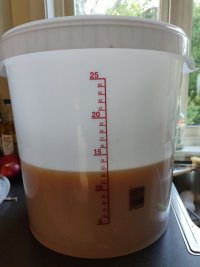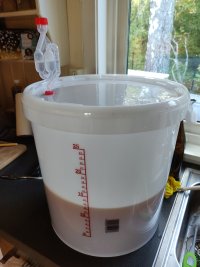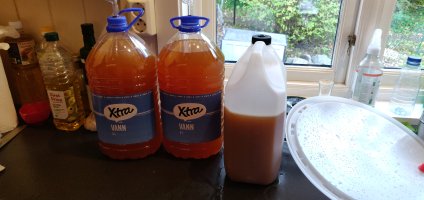Hi everyone..
I have generally brewed beer fom kits and now from all grain. Where I am right now we have apple trees and I am pressing as we speak. They are nice & sweet/tangy eating apples. I expect by tomorrow to have around 12-15 litres of juice (2.5-3.5 gallons). I'd like to try my first cider 'experiment' but have limited equipment and ingredients to hand at this moment in time. I hope to get something fermenting ready for say Christmas time (so no hurry), but I have leave where I am in a week and don't come back until late December, so I'd like to set something up to come an pick up about 2 months time. I was hoping to do something I can "just leave to look after itself".. The temperature here would be only around 10-15c (50-60F) but I could leave the containers at a friend's house at a more 'nommal' 20c (68F).
I now here have a couple of spare 30L (7 gallon) plastic beer fermentation buckets with airlocks & tap holes, or some 5 litre (1 gallon) screw top water containers I could potentially drill the caps in and fit/adapt airlocks into the top of. I have no glass carboys of say 10L (2.2 gallon) which might have been ideal.
So, question, if I want to roll the dice and try to set something up to return to in 2 months (with almost no attention required thoughI do have someone who can visit 'if needed') and maybe drink and/or bottle then, what to do? I have no yeast, so it's a purely fly by night try. Do I try multiple 5L/1 gallon containers with around a 0.75% 'fill', or do I use a 30L/7 gallon beer bucket with all that headspace that would be left? (around 50% headspace).
This is an experiment, so nothing lost if it goes wrong, but I'd like to learn, make use of these apples, and maybe have some Christmas cheer to show for it!
Thanks so much for any (quick) responses..
I have generally brewed beer fom kits and now from all grain. Where I am right now we have apple trees and I am pressing as we speak. They are nice & sweet/tangy eating apples. I expect by tomorrow to have around 12-15 litres of juice (2.5-3.5 gallons). I'd like to try my first cider 'experiment' but have limited equipment and ingredients to hand at this moment in time. I hope to get something fermenting ready for say Christmas time (so no hurry), but I have leave where I am in a week and don't come back until late December, so I'd like to set something up to come an pick up about 2 months time. I was hoping to do something I can "just leave to look after itself".. The temperature here would be only around 10-15c (50-60F) but I could leave the containers at a friend's house at a more 'nommal' 20c (68F).
I now here have a couple of spare 30L (7 gallon) plastic beer fermentation buckets with airlocks & tap holes, or some 5 litre (1 gallon) screw top water containers I could potentially drill the caps in and fit/adapt airlocks into the top of. I have no glass carboys of say 10L (2.2 gallon) which might have been ideal.
So, question, if I want to roll the dice and try to set something up to return to in 2 months (with almost no attention required thoughI do have someone who can visit 'if needed') and maybe drink and/or bottle then, what to do? I have no yeast, so it's a purely fly by night try. Do I try multiple 5L/1 gallon containers with around a 0.75% 'fill', or do I use a 30L/7 gallon beer bucket with all that headspace that would be left? (around 50% headspace).
This is an experiment, so nothing lost if it goes wrong, but I'd like to learn, make use of these apples, and maybe have some Christmas cheer to show for it!
Thanks so much for any (quick) responses..
Last edited:










![Craft A Brew - Safale BE-256 Yeast - Fermentis - Belgian Ale Dry Yeast - For Belgian & Strong Ales - Ingredients for Home Brewing - Beer Making Supplies - [3 Pack]](https://m.media-amazon.com/images/I/51bcKEwQmWL._SL500_.jpg)




















































